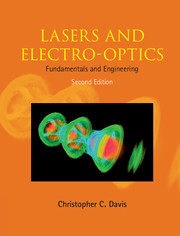Book contents
- Frontmatter
- Contents
- Preface to the Second Edition
- 1 Electromagnetic waves, light, and lasers
- 2 Optical frequency amplifiers
- 3 An introduction to two practical laser systems
- 4 Optical resonators containing amplifying media
- 5 Laser radiation
- 6 Control of laser oscillators
- 7 Optically pumped solid-state lasers
- 8 Gas lasers
- 9 Molecular gas lasers I
- 10 Molecular gas lasers II
- 11 Tunable lasers
- 12 Semiconductor lasers
- 13 Passive optical systems
- 14 Periodic optical systems, resonators, and inhomogeneous media
- 15 The optics of Gaussian beams
- 16 Optical fibers and waveguides
- 17 The optics of anisotropic media
- 18 The electro-optic and acousto-optic effects and modulation of light beams
- 19 Introduction to nonlinear processes
- 20 Wave propagation in nonlinear media
- 21 Detection of optical radiation
- 22 Coherence theory
- 23 Laser applications
- Appendix 1 Optical terminology
- Appendix 2 The ´-function
- Appendix 3 Black-body radiation formulas
- Appendix 4 RLC circuits
- Appendix 5 Storage and transport of energy by electromagnetic fields
- Appendix 6 The reflection and refraction of a plane electromagnetic wave at a boundary between two isotropicmedia of different refractive indices
- Appendix 7 The vector differential equation for light rays
- Appendix 8 Symmetry properties of crystals and the 32 crystal classes
- Appendix 9 Tensors
- Appendix 10 Bessel-function relations
- Appendix 11 Green's functions
- Appendix 12 Recommended values of some physical constants
- Index
- References
1 - Electromagnetic waves, light, and lasers
Published online by Cambridge University Press: 05 June 2014
- Frontmatter
- Contents
- Preface to the Second Edition
- 1 Electromagnetic waves, light, and lasers
- 2 Optical frequency amplifiers
- 3 An introduction to two practical laser systems
- 4 Optical resonators containing amplifying media
- 5 Laser radiation
- 6 Control of laser oscillators
- 7 Optically pumped solid-state lasers
- 8 Gas lasers
- 9 Molecular gas lasers I
- 10 Molecular gas lasers II
- 11 Tunable lasers
- 12 Semiconductor lasers
- 13 Passive optical systems
- 14 Periodic optical systems, resonators, and inhomogeneous media
- 15 The optics of Gaussian beams
- 16 Optical fibers and waveguides
- 17 The optics of anisotropic media
- 18 The electro-optic and acousto-optic effects and modulation of light beams
- 19 Introduction to nonlinear processes
- 20 Wave propagation in nonlinear media
- 21 Detection of optical radiation
- 22 Coherence theory
- 23 Laser applications
- Appendix 1 Optical terminology
- Appendix 2 The ´-function
- Appendix 3 Black-body radiation formulas
- Appendix 4 RLC circuits
- Appendix 5 Storage and transport of energy by electromagnetic fields
- Appendix 6 The reflection and refraction of a plane electromagnetic wave at a boundary between two isotropicmedia of different refractive indices
- Appendix 7 The vector differential equation for light rays
- Appendix 8 Symmetry properties of crystals and the 32 crystal classes
- Appendix 9 Tensors
- Appendix 10 Bessel-function relations
- Appendix 11 Green's functions
- Appendix 12 Recommended values of some physical constants
- Index
- References
Summary
The laser
A laser is an oscillator that operates at optical frequencies. These frequencies of operation lie within a spectral region that extends from the very far infrared to the vacuumultraviolet (VUV) or soft-X-ray region. At the lowest frequencies at which they operate, lasers overlap with the frequency coverage of masers, to which they are closely related, and millimeter-wave sources using solid-state or vacuum-tube electronics, such as TRAPATT, IMPATT, and Gunn diodes, klystrons, gyroklystrons, and traveling-wave tube oscillators, whose principles of operation are quite different [1]. In common with electronic-circuit oscillators, a laser is constructed using an amplifier with an appropriate amount of positive feedback. The positive feedback is generally provided by mirrors that re-direct light back and forth through the laser amplifier. The acronym LASER, which stands for light amplification by stimulated emission of radiation, is in reality therefore a slight misnomer.
A little bit of history
The basic physics underlying light emission and absorption by atoms and molecules was first expounded by Albert Einstein (1879–1955) in 1917 [2]. Richard Chace Tolman (1881–1948) observed that stimulated emission could lead to “negative absorption.” In 1928 Rudolph Walther Landenburg (1889–1953) confirmed the existence of stimulated emission and negative absorption. It is interesting to note that a famous spectroscopist, Curtis J. Humphreys (1898–1986), who for most of his career worked at the U.S. Naval Ordnance Laboratory in Corona, California, might have operated the first gas laser without knowing it.
- Type
- Chapter
- Information
- Lasers and Electro-opticsFundamentals and Engineering, pp. 1 - 32Publisher: Cambridge University PressPrint publication year: 2014



